PROJ6006 Assessment 2: EWS Case Study of Leadership and PM Techniques
VerifiedAdded on 2022/10/12
|10
|2360
|304
Case Study
AI Summary
This case study analysis examines Ecological Wastewater Solutions Pty Ltd (EWS) and its approach to organizational behavior and people management within the context of project management. The analysis delves into the rationale behind choosing specific leadership styles, such as democratic leadership, to foster employee engagement and value their opinions. It explores the tools and techniques employed by project managers, including Agile methodology and communication software like ProofHub and Flock, to influence team members, manage communication with stakeholders, and maintain project progress. The study further discusses the five types of power used to motivate team collaboration and the methods for developing self-managed teams within Agile projects. It also outlines the steps a project manager would take to resolve issues and challenges faced by team members, emphasizing the importance of communication, accountability, and performance appraisal. The case study highlights the significance of these strategies in achieving project success and organizational growth, particularly as EWS expands into new markets.
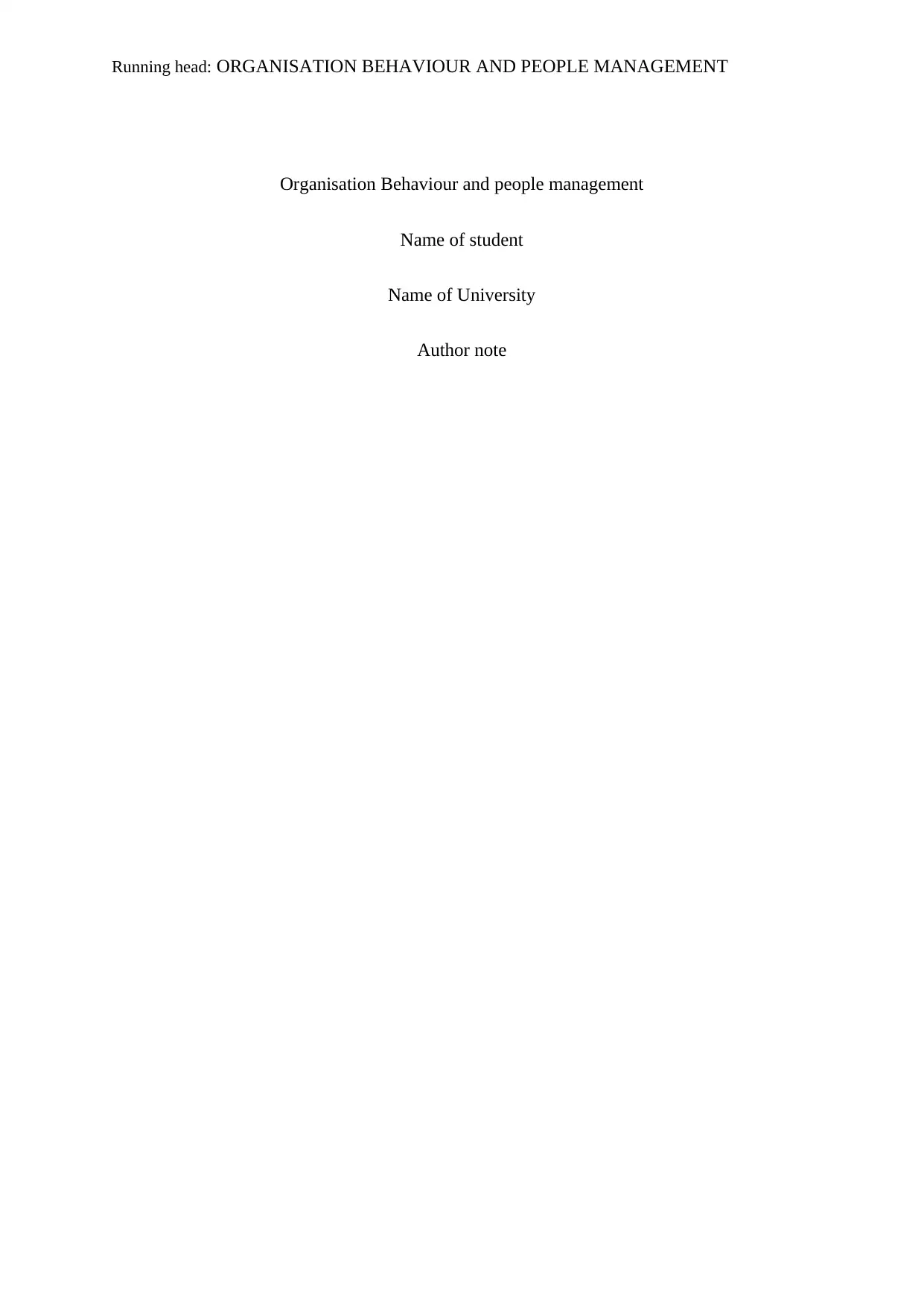
Running head: ORGANISATION BEHAVIOUR AND PEOPLE MANAGEMENT
Organisation Behaviour and people management
Name of student
Name of University
Author note
Organisation Behaviour and people management
Name of student
Name of University
Author note
Paraphrase This Document
Need a fresh take? Get an instant paraphrase of this document with our AI Paraphraser
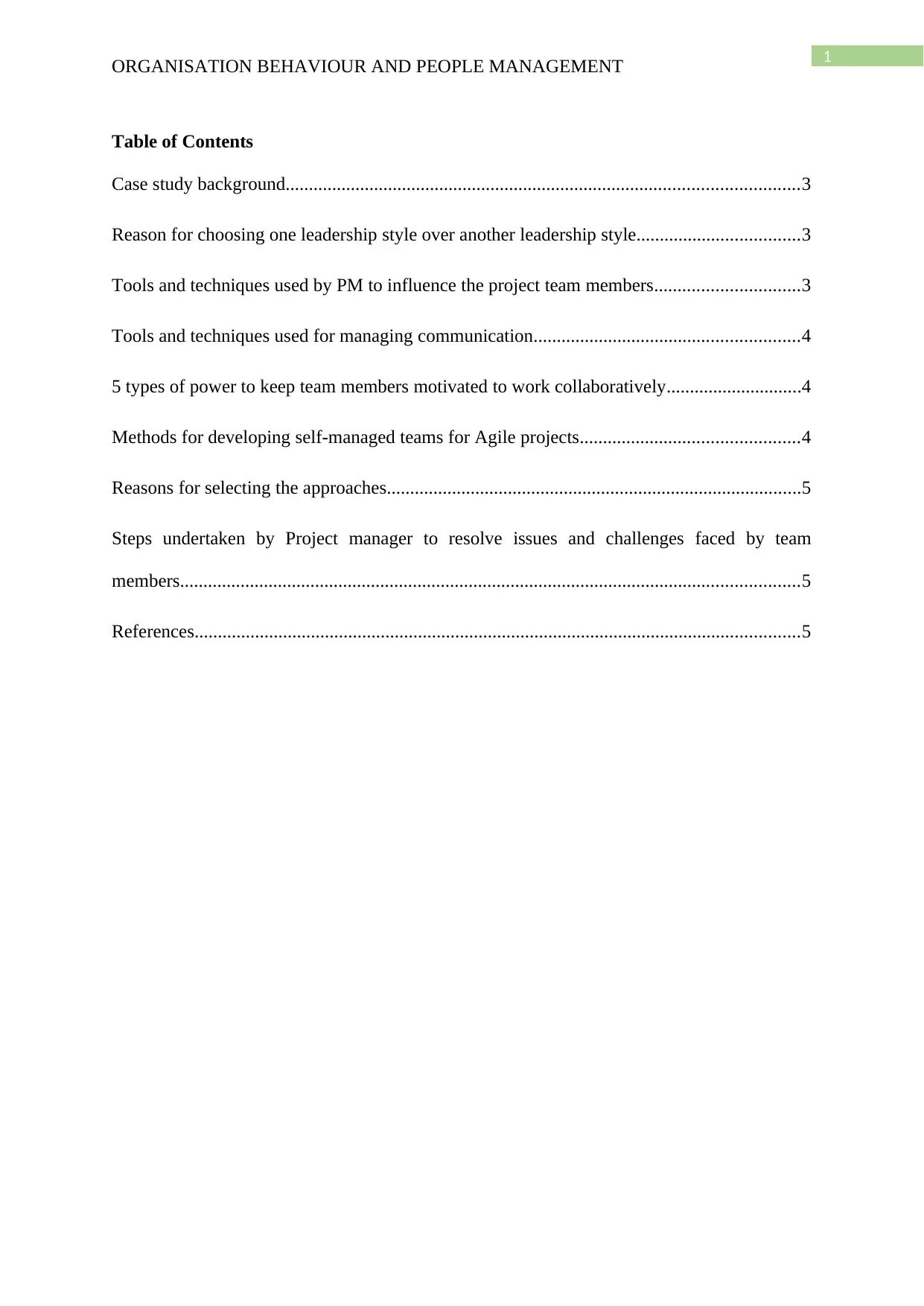
1
ORGANISATION BEHAVIOUR AND PEOPLE MANAGEMENT
Table of Contents
Case study background..............................................................................................................3
Reason for choosing one leadership style over another leadership style...................................3
Tools and techniques used by PM to influence the project team members...............................3
Tools and techniques used for managing communication.........................................................4
5 types of power to keep team members motivated to work collaboratively.............................4
Methods for developing self-managed teams for Agile projects...............................................4
Reasons for selecting the approaches.........................................................................................5
Steps undertaken by Project manager to resolve issues and challenges faced by team
members.....................................................................................................................................5
References..................................................................................................................................5
ORGANISATION BEHAVIOUR AND PEOPLE MANAGEMENT
Table of Contents
Case study background..............................................................................................................3
Reason for choosing one leadership style over another leadership style...................................3
Tools and techniques used by PM to influence the project team members...............................3
Tools and techniques used for managing communication.........................................................4
5 types of power to keep team members motivated to work collaboratively.............................4
Methods for developing self-managed teams for Agile projects...............................................4
Reasons for selecting the approaches.........................................................................................5
Steps undertaken by Project manager to resolve issues and challenges faced by team
members.....................................................................................................................................5
References..................................................................................................................................5
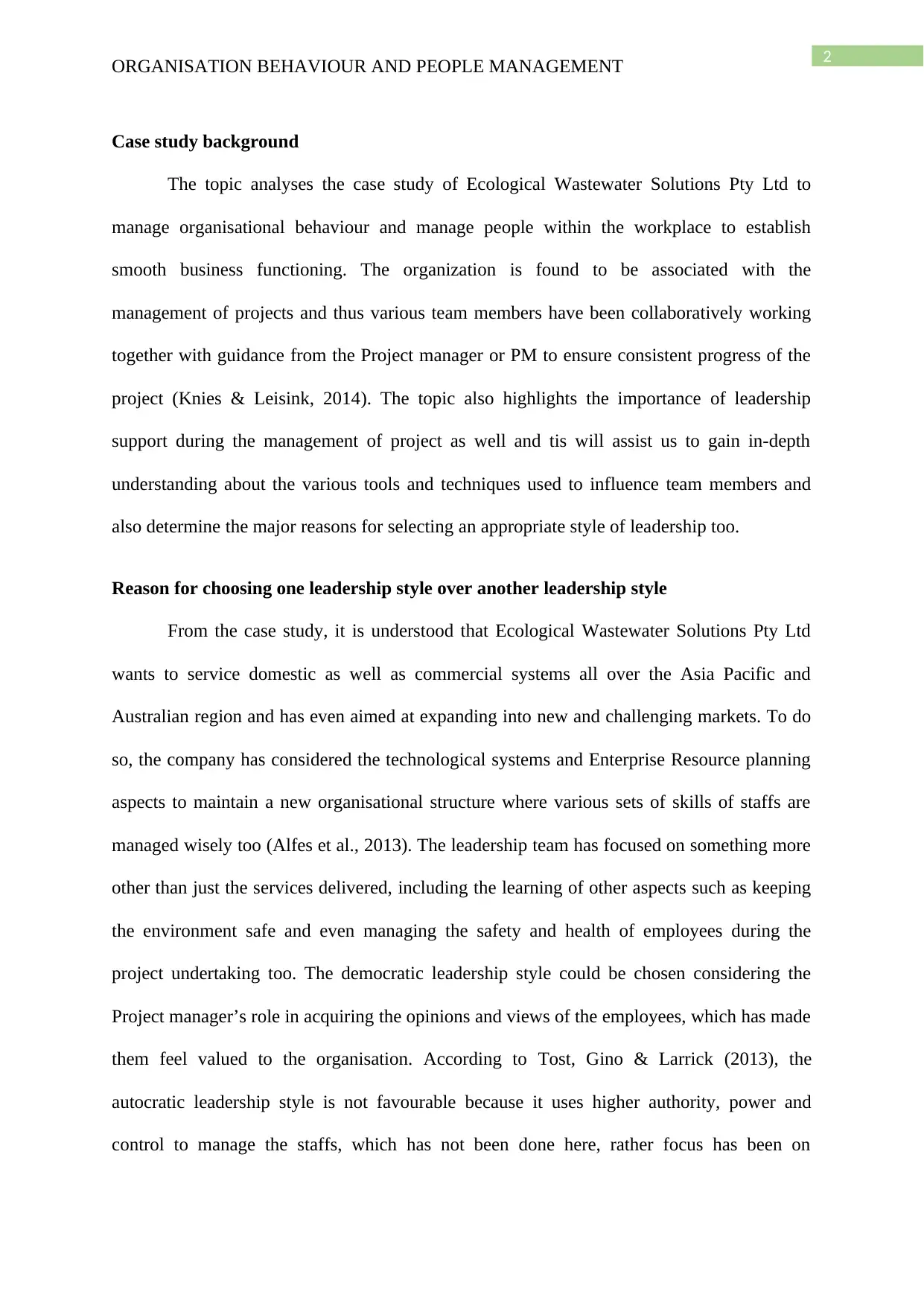
2
ORGANISATION BEHAVIOUR AND PEOPLE MANAGEMENT
Case study background
The topic analyses the case study of Ecological Wastewater Solutions Pty Ltd to
manage organisational behaviour and manage people within the workplace to establish
smooth business functioning. The organization is found to be associated with the
management of projects and thus various team members have been collaboratively working
together with guidance from the Project manager or PM to ensure consistent progress of the
project (Knies & Leisink, 2014). The topic also highlights the importance of leadership
support during the management of project as well and tis will assist us to gain in-depth
understanding about the various tools and techniques used to influence team members and
also determine the major reasons for selecting an appropriate style of leadership too.
Reason for choosing one leadership style over another leadership style
From the case study, it is understood that Ecological Wastewater Solutions Pty Ltd
wants to service domestic as well as commercial systems all over the Asia Pacific and
Australian region and has even aimed at expanding into new and challenging markets. To do
so, the company has considered the technological systems and Enterprise Resource planning
aspects to maintain a new organisational structure where various sets of skills of staffs are
managed wisely too (Alfes et al., 2013). The leadership team has focused on something more
other than just the services delivered, including the learning of other aspects such as keeping
the environment safe and even managing the safety and health of employees during the
project undertaking too. The democratic leadership style could be chosen considering the
Project manager’s role in acquiring the opinions and views of the employees, which has made
them feel valued to the organisation. According to Tost, Gino & Larrick (2013), the
autocratic leadership style is not favourable because it uses higher authority, power and
control to manage the staffs, which has not been done here, rather focus has been on
ORGANISATION BEHAVIOUR AND PEOPLE MANAGEMENT
Case study background
The topic analyses the case study of Ecological Wastewater Solutions Pty Ltd to
manage organisational behaviour and manage people within the workplace to establish
smooth business functioning. The organization is found to be associated with the
management of projects and thus various team members have been collaboratively working
together with guidance from the Project manager or PM to ensure consistent progress of the
project (Knies & Leisink, 2014). The topic also highlights the importance of leadership
support during the management of project as well and tis will assist us to gain in-depth
understanding about the various tools and techniques used to influence team members and
also determine the major reasons for selecting an appropriate style of leadership too.
Reason for choosing one leadership style over another leadership style
From the case study, it is understood that Ecological Wastewater Solutions Pty Ltd
wants to service domestic as well as commercial systems all over the Asia Pacific and
Australian region and has even aimed at expanding into new and challenging markets. To do
so, the company has considered the technological systems and Enterprise Resource planning
aspects to maintain a new organisational structure where various sets of skills of staffs are
managed wisely too (Alfes et al., 2013). The leadership team has focused on something more
other than just the services delivered, including the learning of other aspects such as keeping
the environment safe and even managing the safety and health of employees during the
project undertaking too. The democratic leadership style could be chosen considering the
Project manager’s role in acquiring the opinions and views of the employees, which has made
them feel valued to the organisation. According to Tost, Gino & Larrick (2013), the
autocratic leadership style is not favourable because it uses higher authority, power and
control to manage the staffs, which has not been done here, rather focus has been on
⊘ This is a preview!⊘
Do you want full access?
Subscribe today to unlock all pages.

Trusted by 1+ million students worldwide
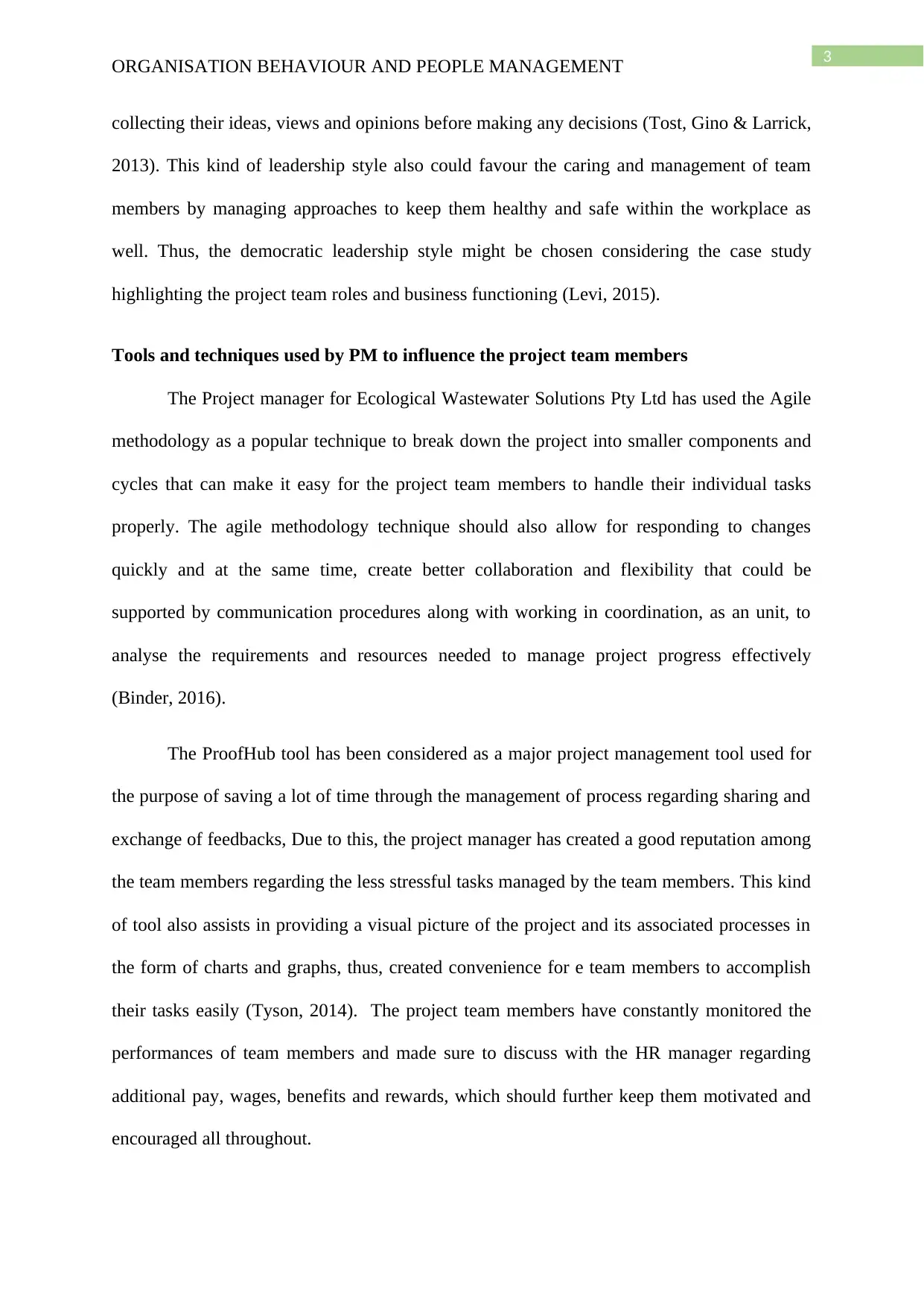
3
ORGANISATION BEHAVIOUR AND PEOPLE MANAGEMENT
collecting their ideas, views and opinions before making any decisions (Tost, Gino & Larrick,
2013). This kind of leadership style also could favour the caring and management of team
members by managing approaches to keep them healthy and safe within the workplace as
well. Thus, the democratic leadership style might be chosen considering the case study
highlighting the project team roles and business functioning (Levi, 2015).
Tools and techniques used by PM to influence the project team members
The Project manager for Ecological Wastewater Solutions Pty Ltd has used the Agile
methodology as a popular technique to break down the project into smaller components and
cycles that can make it easy for the project team members to handle their individual tasks
properly. The agile methodology technique should also allow for responding to changes
quickly and at the same time, create better collaboration and flexibility that could be
supported by communication procedures along with working in coordination, as an unit, to
analyse the requirements and resources needed to manage project progress effectively
(Binder, 2016).
The ProofHub tool has been considered as a major project management tool used for
the purpose of saving a lot of time through the management of process regarding sharing and
exchange of feedbacks, Due to this, the project manager has created a good reputation among
the team members regarding the less stressful tasks managed by the team members. This kind
of tool also assists in providing a visual picture of the project and its associated processes in
the form of charts and graphs, thus, created convenience for e team members to accomplish
their tasks easily (Tyson, 2014). The project team members have constantly monitored the
performances of team members and made sure to discuss with the HR manager regarding
additional pay, wages, benefits and rewards, which should further keep them motivated and
encouraged all throughout.
ORGANISATION BEHAVIOUR AND PEOPLE MANAGEMENT
collecting their ideas, views and opinions before making any decisions (Tost, Gino & Larrick,
2013). This kind of leadership style also could favour the caring and management of team
members by managing approaches to keep them healthy and safe within the workplace as
well. Thus, the democratic leadership style might be chosen considering the case study
highlighting the project team roles and business functioning (Levi, 2015).
Tools and techniques used by PM to influence the project team members
The Project manager for Ecological Wastewater Solutions Pty Ltd has used the Agile
methodology as a popular technique to break down the project into smaller components and
cycles that can make it easy for the project team members to handle their individual tasks
properly. The agile methodology technique should also allow for responding to changes
quickly and at the same time, create better collaboration and flexibility that could be
supported by communication procedures along with working in coordination, as an unit, to
analyse the requirements and resources needed to manage project progress effectively
(Binder, 2016).
The ProofHub tool has been considered as a major project management tool used for
the purpose of saving a lot of time through the management of process regarding sharing and
exchange of feedbacks, Due to this, the project manager has created a good reputation among
the team members regarding the less stressful tasks managed by the team members. This kind
of tool also assists in providing a visual picture of the project and its associated processes in
the form of charts and graphs, thus, created convenience for e team members to accomplish
their tasks easily (Tyson, 2014). The project team members have constantly monitored the
performances of team members and made sure to discuss with the HR manager regarding
additional pay, wages, benefits and rewards, which should further keep them motivated and
encouraged all throughout.
Paraphrase This Document
Need a fresh take? Get an instant paraphrase of this document with our AI Paraphraser
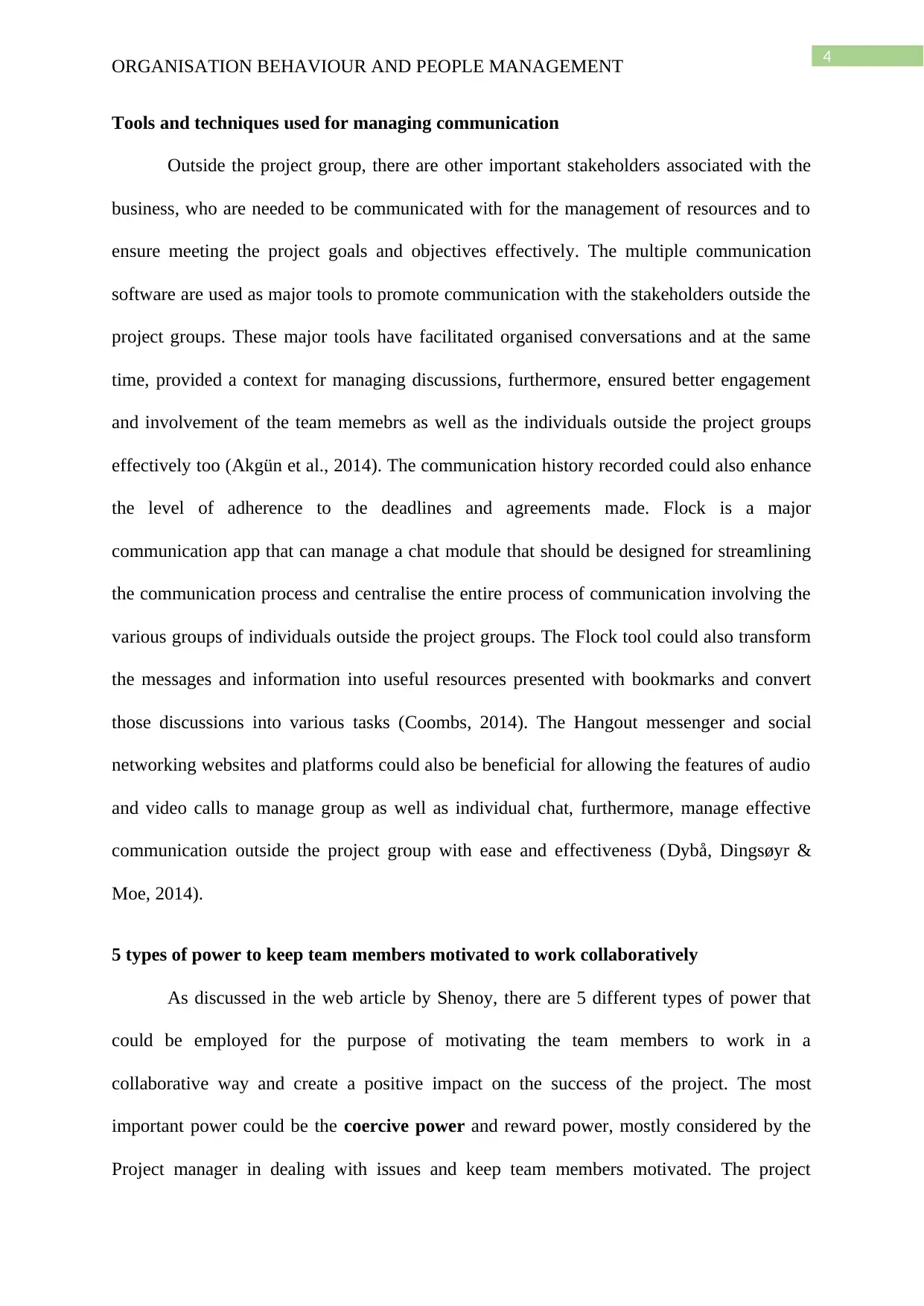
4
ORGANISATION BEHAVIOUR AND PEOPLE MANAGEMENT
Tools and techniques used for managing communication
Outside the project group, there are other important stakeholders associated with the
business, who are needed to be communicated with for the management of resources and to
ensure meeting the project goals and objectives effectively. The multiple communication
software are used as major tools to promote communication with the stakeholders outside the
project groups. These major tools have facilitated organised conversations and at the same
time, provided a context for managing discussions, furthermore, ensured better engagement
and involvement of the team memebrs as well as the individuals outside the project groups
effectively too (Akgün et al., 2014). The communication history recorded could also enhance
the level of adherence to the deadlines and agreements made. Flock is a major
communication app that can manage a chat module that should be designed for streamlining
the communication process and centralise the entire process of communication involving the
various groups of individuals outside the project groups. The Flock tool could also transform
the messages and information into useful resources presented with bookmarks and convert
those discussions into various tasks (Coombs, 2014). The Hangout messenger and social
networking websites and platforms could also be beneficial for allowing the features of audio
and video calls to manage group as well as individual chat, furthermore, manage effective
communication outside the project group with ease and effectiveness (Dybå, Dingsøyr &
Moe, 2014).
5 types of power to keep team members motivated to work collaboratively
As discussed in the web article by Shenoy, there are 5 different types of power that
could be employed for the purpose of motivating the team members to work in a
collaborative way and create a positive impact on the success of the project. The most
important power could be the coercive power and reward power, mostly considered by the
Project manager in dealing with issues and keep team members motivated. The project
ORGANISATION BEHAVIOUR AND PEOPLE MANAGEMENT
Tools and techniques used for managing communication
Outside the project group, there are other important stakeholders associated with the
business, who are needed to be communicated with for the management of resources and to
ensure meeting the project goals and objectives effectively. The multiple communication
software are used as major tools to promote communication with the stakeholders outside the
project groups. These major tools have facilitated organised conversations and at the same
time, provided a context for managing discussions, furthermore, ensured better engagement
and involvement of the team memebrs as well as the individuals outside the project groups
effectively too (Akgün et al., 2014). The communication history recorded could also enhance
the level of adherence to the deadlines and agreements made. Flock is a major
communication app that can manage a chat module that should be designed for streamlining
the communication process and centralise the entire process of communication involving the
various groups of individuals outside the project groups. The Flock tool could also transform
the messages and information into useful resources presented with bookmarks and convert
those discussions into various tasks (Coombs, 2014). The Hangout messenger and social
networking websites and platforms could also be beneficial for allowing the features of audio
and video calls to manage group as well as individual chat, furthermore, manage effective
communication outside the project group with ease and effectiveness (Dybå, Dingsøyr &
Moe, 2014).
5 types of power to keep team members motivated to work collaboratively
As discussed in the web article by Shenoy, there are 5 different types of power that
could be employed for the purpose of motivating the team members to work in a
collaborative way and create a positive impact on the success of the project. The most
important power could be the coercive power and reward power, mostly considered by the
Project manager in dealing with issues and keep team members motivated. The project
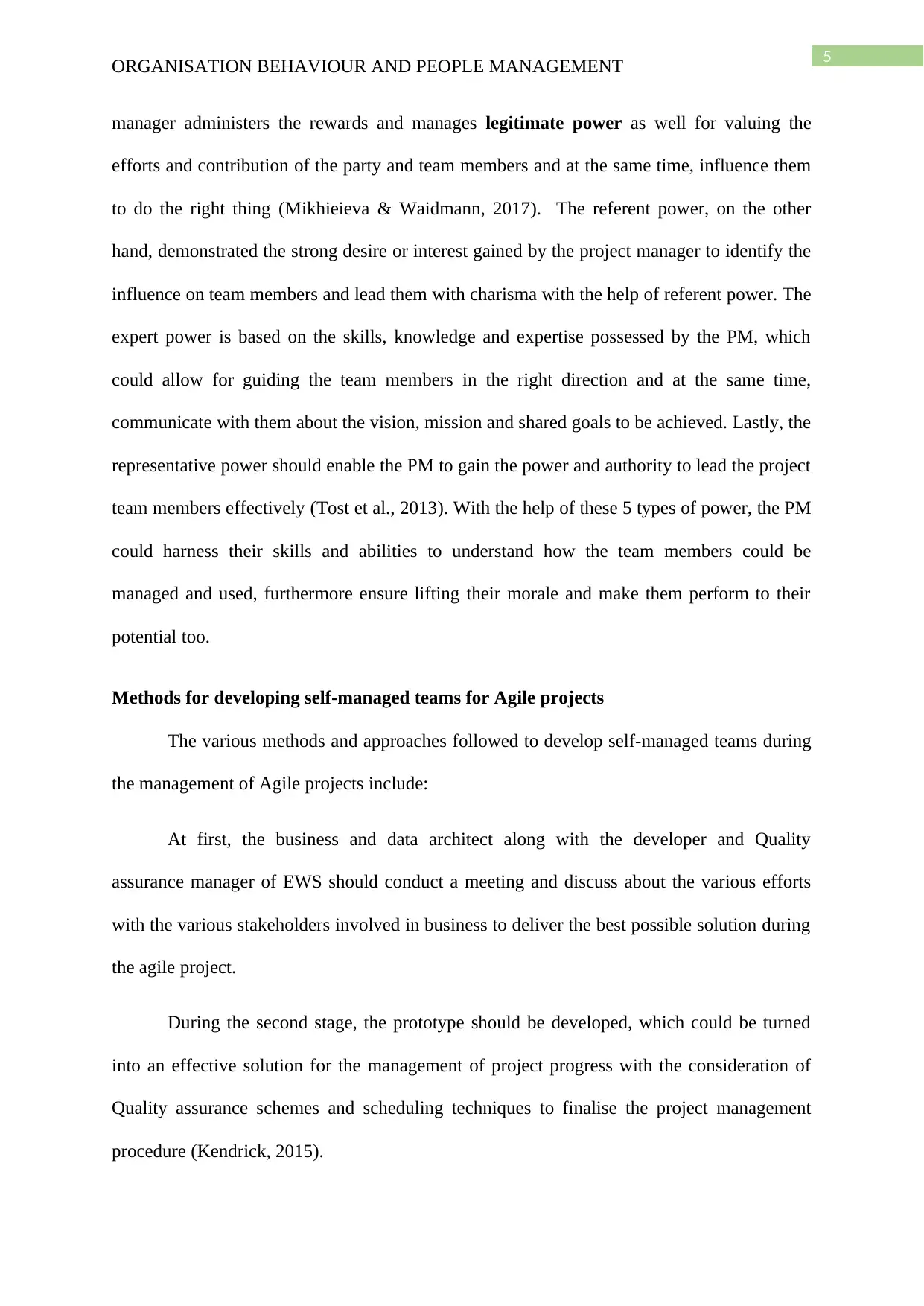
5
ORGANISATION BEHAVIOUR AND PEOPLE MANAGEMENT
manager administers the rewards and manages legitimate power as well for valuing the
efforts and contribution of the party and team members and at the same time, influence them
to do the right thing (Mikhieieva & Waidmann, 2017). The referent power, on the other
hand, demonstrated the strong desire or interest gained by the project manager to identify the
influence on team members and lead them with charisma with the help of referent power. The
expert power is based on the skills, knowledge and expertise possessed by the PM, which
could allow for guiding the team members in the right direction and at the same time,
communicate with them about the vision, mission and shared goals to be achieved. Lastly, the
representative power should enable the PM to gain the power and authority to lead the project
team members effectively (Tost et al., 2013). With the help of these 5 types of power, the PM
could harness their skills and abilities to understand how the team members could be
managed and used, furthermore ensure lifting their morale and make them perform to their
potential too.
Methods for developing self-managed teams for Agile projects
The various methods and approaches followed to develop self-managed teams during
the management of Agile projects include:
At first, the business and data architect along with the developer and Quality
assurance manager of EWS should conduct a meeting and discuss about the various efforts
with the various stakeholders involved in business to deliver the best possible solution during
the agile project.
During the second stage, the prototype should be developed, which could be turned
into an effective solution for the management of project progress with the consideration of
Quality assurance schemes and scheduling techniques to finalise the project management
procedure (Kendrick, 2015).
ORGANISATION BEHAVIOUR AND PEOPLE MANAGEMENT
manager administers the rewards and manages legitimate power as well for valuing the
efforts and contribution of the party and team members and at the same time, influence them
to do the right thing (Mikhieieva & Waidmann, 2017). The referent power, on the other
hand, demonstrated the strong desire or interest gained by the project manager to identify the
influence on team members and lead them with charisma with the help of referent power. The
expert power is based on the skills, knowledge and expertise possessed by the PM, which
could allow for guiding the team members in the right direction and at the same time,
communicate with them about the vision, mission and shared goals to be achieved. Lastly, the
representative power should enable the PM to gain the power and authority to lead the project
team members effectively (Tost et al., 2013). With the help of these 5 types of power, the PM
could harness their skills and abilities to understand how the team members could be
managed and used, furthermore ensure lifting their morale and make them perform to their
potential too.
Methods for developing self-managed teams for Agile projects
The various methods and approaches followed to develop self-managed teams during
the management of Agile projects include:
At first, the business and data architect along with the developer and Quality
assurance manager of EWS should conduct a meeting and discuss about the various efforts
with the various stakeholders involved in business to deliver the best possible solution during
the agile project.
During the second stage, the prototype should be developed, which could be turned
into an effective solution for the management of project progress with the consideration of
Quality assurance schemes and scheduling techniques to finalise the project management
procedure (Kendrick, 2015).
⊘ This is a preview!⊘
Do you want full access?
Subscribe today to unlock all pages.

Trusted by 1+ million students worldwide
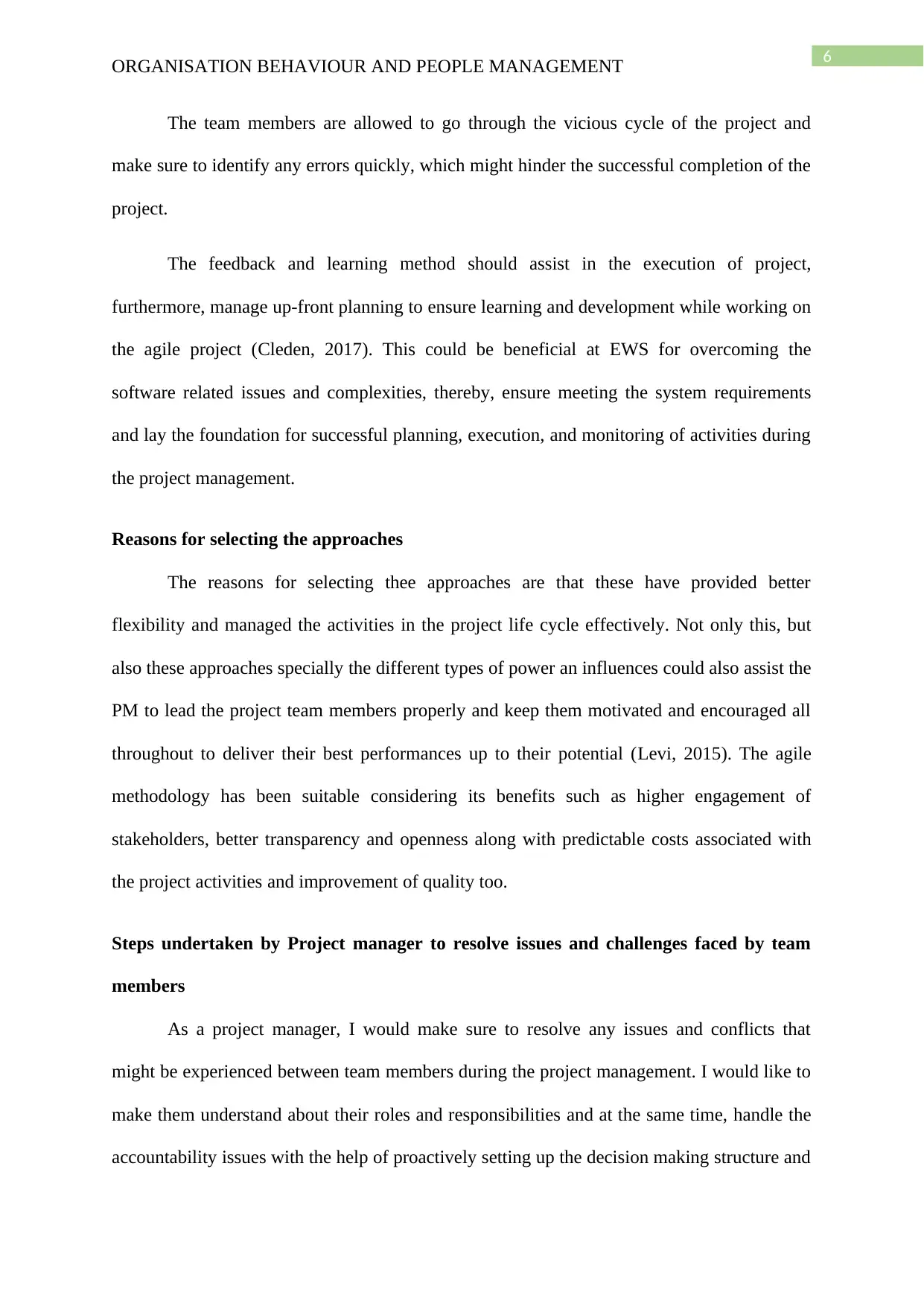
6
ORGANISATION BEHAVIOUR AND PEOPLE MANAGEMENT
The team members are allowed to go through the vicious cycle of the project and
make sure to identify any errors quickly, which might hinder the successful completion of the
project.
The feedback and learning method should assist in the execution of project,
furthermore, manage up-front planning to ensure learning and development while working on
the agile project (Cleden, 2017). This could be beneficial at EWS for overcoming the
software related issues and complexities, thereby, ensure meeting the system requirements
and lay the foundation for successful planning, execution, and monitoring of activities during
the project management.
Reasons for selecting the approaches
The reasons for selecting thee approaches are that these have provided better
flexibility and managed the activities in the project life cycle effectively. Not only this, but
also these approaches specially the different types of power an influences could also assist the
PM to lead the project team members properly and keep them motivated and encouraged all
throughout to deliver their best performances up to their potential (Levi, 2015). The agile
methodology has been suitable considering its benefits such as higher engagement of
stakeholders, better transparency and openness along with predictable costs associated with
the project activities and improvement of quality too.
Steps undertaken by Project manager to resolve issues and challenges faced by team
members
As a project manager, I would make sure to resolve any issues and conflicts that
might be experienced between team members during the project management. I would like to
make them understand about their roles and responsibilities and at the same time, handle the
accountability issues with the help of proactively setting up the decision making structure and
ORGANISATION BEHAVIOUR AND PEOPLE MANAGEMENT
The team members are allowed to go through the vicious cycle of the project and
make sure to identify any errors quickly, which might hinder the successful completion of the
project.
The feedback and learning method should assist in the execution of project,
furthermore, manage up-front planning to ensure learning and development while working on
the agile project (Cleden, 2017). This could be beneficial at EWS for overcoming the
software related issues and complexities, thereby, ensure meeting the system requirements
and lay the foundation for successful planning, execution, and monitoring of activities during
the project management.
Reasons for selecting the approaches
The reasons for selecting thee approaches are that these have provided better
flexibility and managed the activities in the project life cycle effectively. Not only this, but
also these approaches specially the different types of power an influences could also assist the
PM to lead the project team members properly and keep them motivated and encouraged all
throughout to deliver their best performances up to their potential (Levi, 2015). The agile
methodology has been suitable considering its benefits such as higher engagement of
stakeholders, better transparency and openness along with predictable costs associated with
the project activities and improvement of quality too.
Steps undertaken by Project manager to resolve issues and challenges faced by team
members
As a project manager, I would make sure to resolve any issues and conflicts that
might be experienced between team members during the project management. I would like to
make them understand about their roles and responsibilities and at the same time, handle the
accountability issues with the help of proactively setting up the decision making structure and
Paraphrase This Document
Need a fresh take? Get an instant paraphrase of this document with our AI Paraphraser
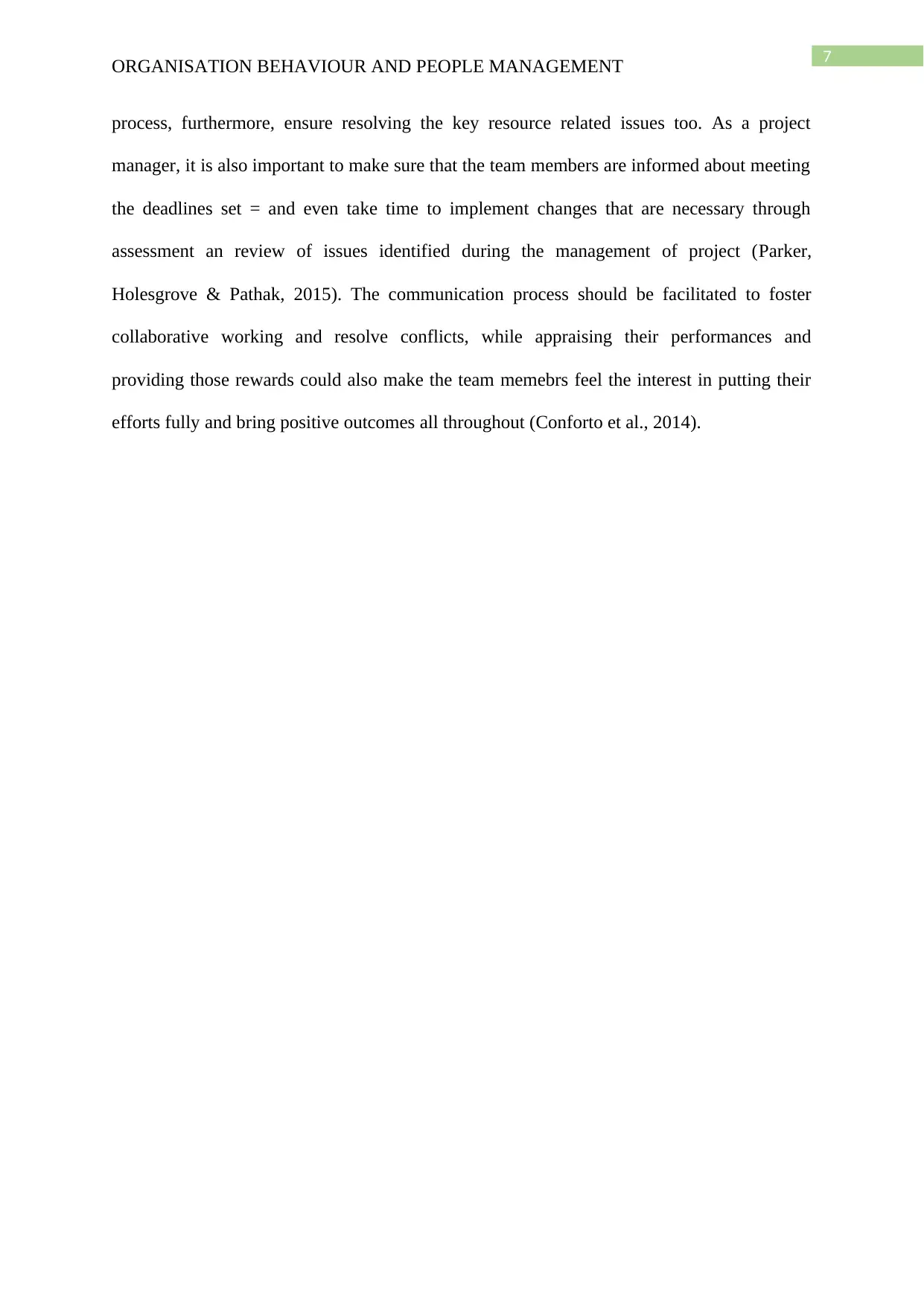
7
ORGANISATION BEHAVIOUR AND PEOPLE MANAGEMENT
process, furthermore, ensure resolving the key resource related issues too. As a project
manager, it is also important to make sure that the team members are informed about meeting
the deadlines set = and even take time to implement changes that are necessary through
assessment an review of issues identified during the management of project (Parker,
Holesgrove & Pathak, 2015). The communication process should be facilitated to foster
collaborative working and resolve conflicts, while appraising their performances and
providing those rewards could also make the team memebrs feel the interest in putting their
efforts fully and bring positive outcomes all throughout (Conforto et al., 2014).
ORGANISATION BEHAVIOUR AND PEOPLE MANAGEMENT
process, furthermore, ensure resolving the key resource related issues too. As a project
manager, it is also important to make sure that the team members are informed about meeting
the deadlines set = and even take time to implement changes that are necessary through
assessment an review of issues identified during the management of project (Parker,
Holesgrove & Pathak, 2015). The communication process should be facilitated to foster
collaborative working and resolve conflicts, while appraising their performances and
providing those rewards could also make the team memebrs feel the interest in putting their
efforts fully and bring positive outcomes all throughout (Conforto et al., 2014).
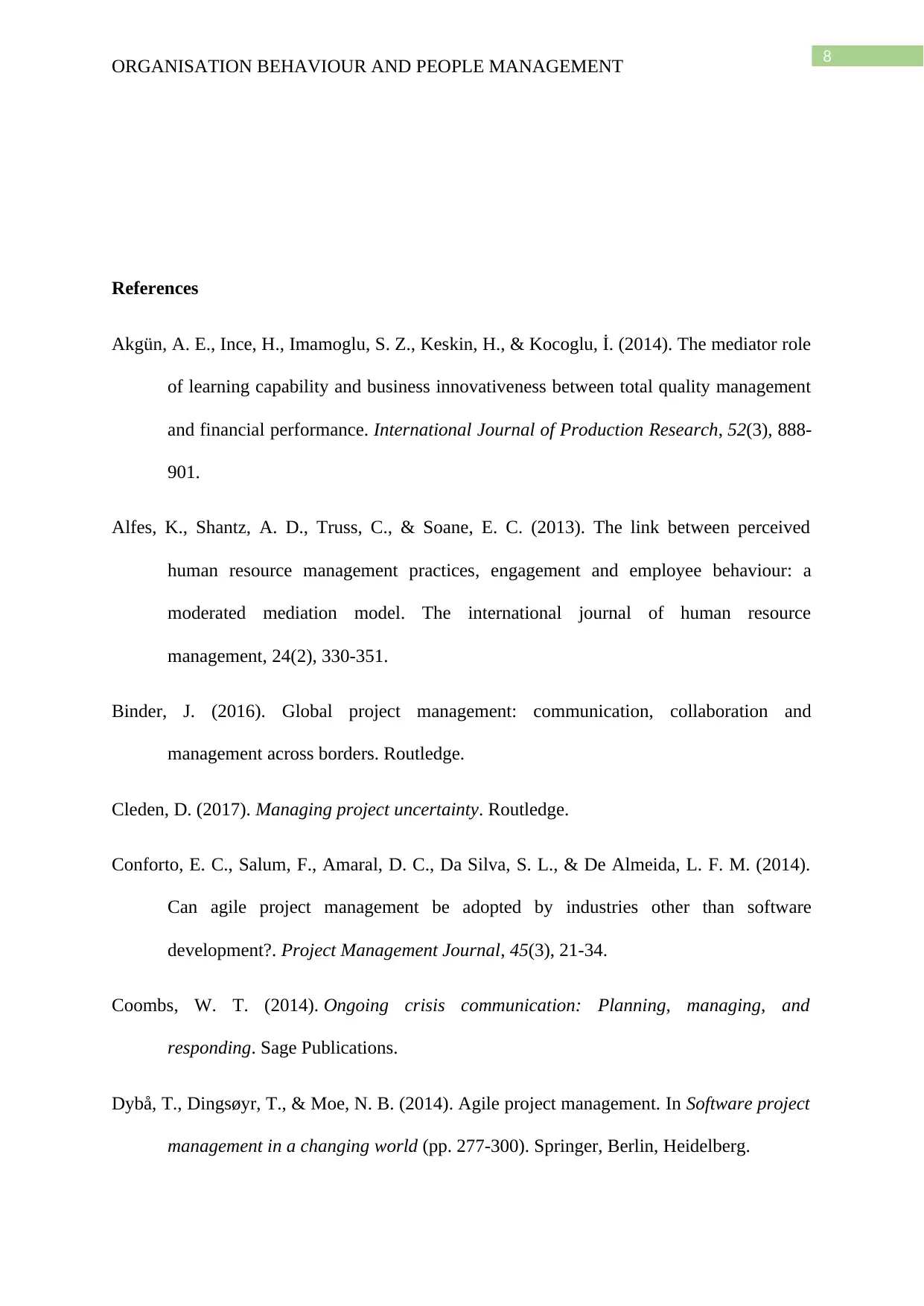
8
ORGANISATION BEHAVIOUR AND PEOPLE MANAGEMENT
References
Akgün, A. E., Ince, H., Imamoglu, S. Z., Keskin, H., & Kocoglu, İ. (2014). The mediator role
of learning capability and business innovativeness between total quality management
and financial performance. International Journal of Production Research, 52(3), 888-
901.
Alfes, K., Shantz, A. D., Truss, C., & Soane, E. C. (2013). The link between perceived
human resource management practices, engagement and employee behaviour: a
moderated mediation model. The international journal of human resource
management, 24(2), 330-351.
Binder, J. (2016). Global project management: communication, collaboration and
management across borders. Routledge.
Cleden, D. (2017). Managing project uncertainty. Routledge.
Conforto, E. C., Salum, F., Amaral, D. C., Da Silva, S. L., & De Almeida, L. F. M. (2014).
Can agile project management be adopted by industries other than software
development?. Project Management Journal, 45(3), 21-34.
Coombs, W. T. (2014). Ongoing crisis communication: Planning, managing, and
responding. Sage Publications.
Dybå, T., Dingsøyr, T., & Moe, N. B. (2014). Agile project management. In Software project
management in a changing world (pp. 277-300). Springer, Berlin, Heidelberg.
ORGANISATION BEHAVIOUR AND PEOPLE MANAGEMENT
References
Akgün, A. E., Ince, H., Imamoglu, S. Z., Keskin, H., & Kocoglu, İ. (2014). The mediator role
of learning capability and business innovativeness between total quality management
and financial performance. International Journal of Production Research, 52(3), 888-
901.
Alfes, K., Shantz, A. D., Truss, C., & Soane, E. C. (2013). The link between perceived
human resource management practices, engagement and employee behaviour: a
moderated mediation model. The international journal of human resource
management, 24(2), 330-351.
Binder, J. (2016). Global project management: communication, collaboration and
management across borders. Routledge.
Cleden, D. (2017). Managing project uncertainty. Routledge.
Conforto, E. C., Salum, F., Amaral, D. C., Da Silva, S. L., & De Almeida, L. F. M. (2014).
Can agile project management be adopted by industries other than software
development?. Project Management Journal, 45(3), 21-34.
Coombs, W. T. (2014). Ongoing crisis communication: Planning, managing, and
responding. Sage Publications.
Dybå, T., Dingsøyr, T., & Moe, N. B. (2014). Agile project management. In Software project
management in a changing world (pp. 277-300). Springer, Berlin, Heidelberg.
⊘ This is a preview!⊘
Do you want full access?
Subscribe today to unlock all pages.

Trusted by 1+ million students worldwide
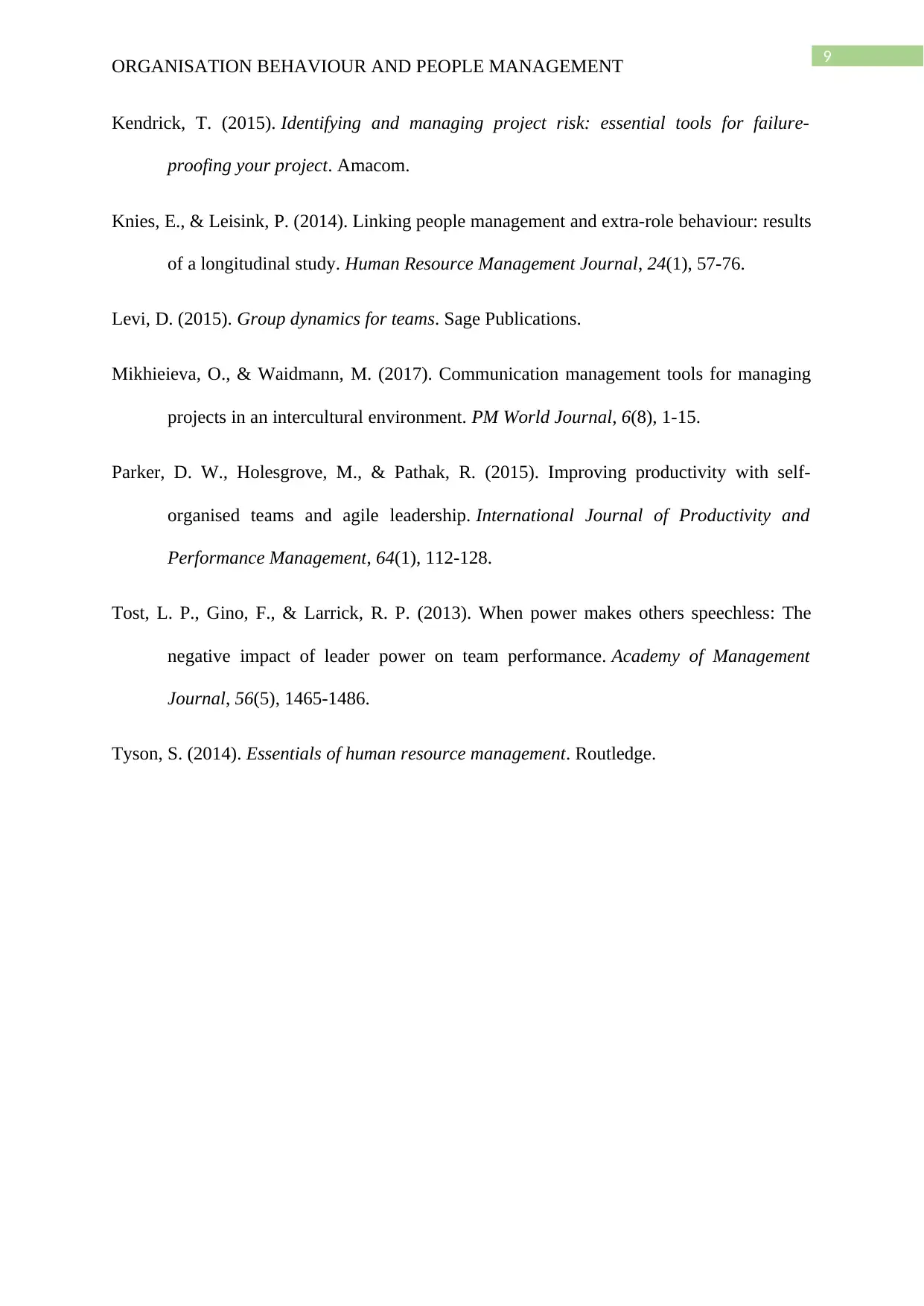
9
ORGANISATION BEHAVIOUR AND PEOPLE MANAGEMENT
Kendrick, T. (2015). Identifying and managing project risk: essential tools for failure-
proofing your project. Amacom.
Knies, E., & Leisink, P. (2014). Linking people management and extra‐role behaviour: results
of a longitudinal study. Human Resource Management Journal, 24(1), 57-76.
Levi, D. (2015). Group dynamics for teams. Sage Publications.
Mikhieieva, O., & Waidmann, M. (2017). Communication management tools for managing
projects in an intercultural environment. PM World Journal, 6(8), 1-15.
Parker, D. W., Holesgrove, M., & Pathak, R. (2015). Improving productivity with self-
organised teams and agile leadership. International Journal of Productivity and
Performance Management, 64(1), 112-128.
Tost, L. P., Gino, F., & Larrick, R. P. (2013). When power makes others speechless: The
negative impact of leader power on team performance. Academy of Management
Journal, 56(5), 1465-1486.
Tyson, S. (2014). Essentials of human resource management. Routledge.
ORGANISATION BEHAVIOUR AND PEOPLE MANAGEMENT
Kendrick, T. (2015). Identifying and managing project risk: essential tools for failure-
proofing your project. Amacom.
Knies, E., & Leisink, P. (2014). Linking people management and extra‐role behaviour: results
of a longitudinal study. Human Resource Management Journal, 24(1), 57-76.
Levi, D. (2015). Group dynamics for teams. Sage Publications.
Mikhieieva, O., & Waidmann, M. (2017). Communication management tools for managing
projects in an intercultural environment. PM World Journal, 6(8), 1-15.
Parker, D. W., Holesgrove, M., & Pathak, R. (2015). Improving productivity with self-
organised teams and agile leadership. International Journal of Productivity and
Performance Management, 64(1), 112-128.
Tost, L. P., Gino, F., & Larrick, R. P. (2013). When power makes others speechless: The
negative impact of leader power on team performance. Academy of Management
Journal, 56(5), 1465-1486.
Tyson, S. (2014). Essentials of human resource management. Routledge.
1 out of 10
Related Documents
Your All-in-One AI-Powered Toolkit for Academic Success.
+13062052269
info@desklib.com
Available 24*7 on WhatsApp / Email
![[object Object]](/_next/static/media/star-bottom.7253800d.svg)
Unlock your academic potential
Copyright © 2020–2025 A2Z Services. All Rights Reserved. Developed and managed by ZUCOL.





